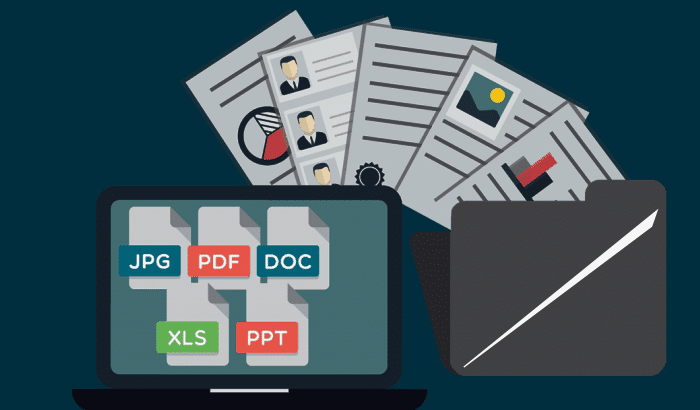In today’s digital age, efficient document management is crucial for businesses of all sizes. The ability to organize, store, and retrieve documents quickly and accurately can significantly improve productivity and streamline workflows.
With a myriad of document management systems available in the market, choosing the right one can be a daunting task. To help you in your search, we have compiled a list of the 20 best document management systems for better workflow.
Whether you’re a small business owner or an enterprise-level organization, these systems offer a wide range of features to suit your specific needs.
Daftar Isi :
What Are Document Management Systems?
Document management systems, also known as DMS, are software applications designed to manage, organize, and track electronic documents and files. These systems provide a centralized repository where users can store, search, and retrieve documents quickly and securely. Document management systems offer features such as version control, collaboration tools, document indexing, metadata tagging, and access controls to ensure efficient document handling.
The Importance of Document Management Systems
Efficient document management is vital for organizations to maintain a streamlined workflow and ensure compliance with regulatory requirements. Here are some key reasons why document management systems are essential:
1. Improved Organization
Document management systems help businesses organize their documents in a structured manner, making it easier to locate and retrieve information when needed.
2. Enhanced Productivity
With document management systems, employees spend less time searching for documents, allowing them to focus on more valuable tasks that contribute to business growth.
3. Streamlined Collaboration
Document management systems facilitate seamless collaboration among team members, enabling them to work together on documents in real-time, regardless of their physical location.
4. Version Control and Audit Trail
These systems maintain a detailed history of document versions and changes, providing a reliable audit trail for compliance purposes and allowing users to revert to previous versions if necessary.
5. Security and Access Control
Document management systems offer robust security features, including user authentication, access controls, and encryption, ensuring that sensitive information remains confidential and accessible only to authorized individuals.
Key Features to Look for in Document Management Systems
When selecting a document management system for your organization, it’s important to consider the following key features:
1. Document Capture and Scanning
Look for systems that offer seamless document capture and scanning capabilities, allowing you to convert physical documents into digital format effortlessly.
2. Search and Retrieval
An efficient search functionality is crucial for quick and accurate retrieval of documents. Look for systems that offer advanced search options, including full-text search, metadata search, and filters.
3. Version Control
Ensure that the system provides robust version control features, allowing you to track changes, manage document versions, and maintain an audit trail.
4. Collaboration Tools
Look for systems that offer real-time collaboration features, such as simultaneous editing, commenting, and document sharing, to enhance team collaboration and productivity.
5. Security and Access Controls
Consider systems that provide strong security measures, including user authentication, role-based access control, encryption, and data backup, to protect sensitive information.
6. Integration Capabilities
It’s essential to choose a document management system that integrates seamlessly with your existing software applications, such as customer relationship management (CRM) systems, project management tools, and email clients.
7. Mobile Accessibility
In today’s mobile-centric world, having a document management system that offers mobile accessibility ensures that users can access and manage documents on the go, enhancing productivity.
8. Scalability
Consider the scalability of the system to accommodate your organization’s growing document management needs. Look for systems that can handle large volumes of data without compromising performance.
9. User-Friendly Interface
A user-friendly interface is crucial for user adoption and minimizing the learning curve. Look for systems with intuitive interfaces and easy-to-navigate menus.
10. Customer Support
Lastly, ensure that the document management system provider offers reliable customer support to address any technical issues or concerns that may arise during implementation and daily usage.
Top 20 Document Management Systems
Now let’s dive into the details of the top 20 document management systems that can significantly improve your workflow and document handling processes:
1. Microsoft SharePoint
Microsoft SharePoint is a widely used document management system that offers comprehensive features for document storage, version control, collaboration, and workflow management. It integrates well with other Microsoft Office applications and provides robust security and access control options.
2. Box
Box is a cloud-based document management platform that enables secure storage, sharing, and collaboration on files. It offers features such as file versioning, granular access controls, and integrations with popular productivity tools. Box is known for its strong security measures and compliance with industry regulations.
3. Google Drive
Google Drive is a cloud storage and document management platform that provides users with free storage space and the ability to create, store, and collaborate on documents, spreadsheets, and presentations. It integrates seamlessly with other Google Workspace applications and offers real-time collaboration features.
4. Dropbox Business
Dropbox Business is a cloud-based document management solution that provides secure file storage, sharing, and collaboration features. It offers advanced admin controls, file versioning, and integrations with various productivity tools. Dropbox Business is known for its simplicity and ease of use.
5. Adobe Document Cloud
Adobe Document Cloud is a comprehensive document management system that enables users to create, edit, sign, and securely store documents in the cloud. It offers features such as PDF editing, e-signatures, document tracking, and integrations with Adobe Creative Cloud applications.
6. M-Files
M-Files is an intelligent document management system that uses metadata-based organization to streamline document retrieval and management. It offers features like automated workflows, version control, compliance management, and integrations with other business systems.
7. OpenText Content Suite
OpenText Content Suite is an enterprise-level document management system that provides a centralized platform for managing content across an organization. It offers features like document lifecycle management, records management, workflow automation, and extensive compliance and security capabilities.
8. Alfresco
Alfresco is an open-source document management system that offers features for document collaboration, version control, and workflow management. It provides integration with other business systems and allows customization and extension through its open architecture.
9. Zoho Docs
Zoho Docs is a cloud-based document management system that offers features for document creation, storage, collaboration, and sharing. It provides integrations with other Zoho applications and offers robust security and access controls.
10. DocuWare
DocuWare is a document management and workflow automation system that enables businesses to digitize, store, and manage documents securely. It offers features like intelligent indexing, full-text search, workflow automation, and integration with other business applications.
11. SharePoint Online
SharePoint Online is the cloud-based version of Microsoft SharePoint, offering similar document management features as the on-premises version. It allows users to store, share, and collaborate on documents while providing the scalability and flexibility of cloud storage.
12. Evernote Business
Evernote Business is a note-taking and document management platform that allows users to capture, organize, and share notes, documents, and images. It offers features like tagging, search functionality, and integrations with other productivity tools.
13. IBM FileNet
IBM FileNet is an enterprise-level document management system that provides features for document capture, storage, retrieval, and workflow management. It offers scalability, advanced security, and compliance capabilities for managing large volumes of documents.
14. OneDrive for Business
OneDrive for Business is a cloud storage and document management platform integrated with Microsoft Office 365. It allows users to store, sync, and share documents securely while providing access controls and version history.
15. Citrix ShareFile
Citrix ShareFile is a file-sharing and document management platform designed for businesses. It offers features like secure file sharing, synchronization, and collaboration, with advanced security options and integrations with other business applications.
16. eFileCabinet
eFileCabinet is a document management system that helps businesses manage, store, and retrieve documents efficiently. It offers features like document scanning, OCR (optical character recognition), workflow automation, and compliance management.
17. OnBase by Hyland
OnBase by Hyland is an enterprise content management platform that offers document management, workflow automation, and case management capabilities. It provides a unified platform for managing documents, processes, and data across an organization.
18. Laserfiche
Laserfiche is a document management and business process automation platform that allows organizations to digitize, store, and manage documents effectively. It offers features like document imaging, workflow automation, and compliance management.
19. Nuxeo
Nuxeo is an open-source content services platform that offers document management, digital asset management, and workflow automation capabilities. It provides extensibility and customization options through its modular architecture.
20. Orangedox
Orangedox is a document management and analytics platform designed specifically for managing and tracking shared documents. It offers features like document tracking, real-time analytics, and integrations with cloud storage providers like Google Drive and Dropbox.
These document management systems provide a range of features and capabilities to help businesses organize, store, and collaborate on documents efficiently. The choice of the most suitable system depends on factors such as the size of the organization, specific requirements, integration needs, and budget considerations.
Frequently Asked Questions
FAQ 1: How do document management systems improve workflow?
Document management systems improve workflow by streamlining document processes, facilitating document collaboration, and providing efficient search and retrieval capabilities. These systems automate repetitive tasks, eliminate manual paperwork, ensure document version control, and enhance document security, leading to increased productivity and reduced errors.
FAQ 2: Can document management systems handle large volumes of data?
Yes, document management systems are designed to handle large volumes of data. They offer scalable storage options, advanced indexing techniques, and efficient search algorithms to manage and retrieve documents quickly, even in environments with extensive document repositories.
FAQ 3: Are these systems suitable for remote work environments?
Absolutely! Document management systems are well-suited for remote work environments. With their cloud-based architecture and mobile accessibility, these systems enable remote employees to access and collaborate on documents from anywhere, ensuring seamless workflow continuity.
FAQ 4: Can document management systems enhance security?
Yes, document management systems enhance security through various measures. They offer user authentication, access controls, encryption, and audit trails to protect sensitive information from unauthorized access. Additionally, these systems provide data backup and recovery capabilities to safeguard against data loss.
FAQ 5: Can document management systems integrate with other software applications?
Yes, document management systems can integrate with other software applications. They offer integration capabilities through APIs, connectors, and plugins, allowing seamless data exchange and interoperability with CRM systems, project management tools, accounting software, and more.
FAQ 6: What is the cost of implementing a document management system?
The cost of implementing a document management system varies depending on factors such as the size of the organization, the chosen system’s features, deployment options (on-premises or cloud-based), and any additional customization or integration requirements. It’s best to contact document management system providers for accurate pricing information based on your specific needs.
Conclusion
In today’s digital age, efficient document management is crucial for organizations to maintain productivity, streamline workflows, and ensure data security.
The top 20 document management systems discussed in this article offer a wide range of features and capabilities to meet diverse organizational needs.
From all-in-one solutions to cloud-based platforms, collaboration-focused systems to security specialists, these document management systems empower organizations to achieve better workflow and document handling processes.
By implementing a suitable document management system, organizations can unlock the full potential of their documents, enhance collaboration, improve productivity, and achieve a competitive edge in their respective industries.
So, take the time to evaluate your organization’s requirements, explore the features of these top systems, and choose the one that aligns best with your workflow and document management needs.
Read Also:

